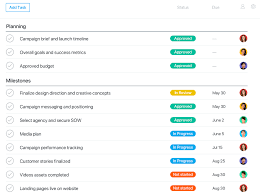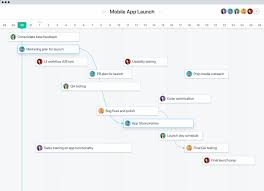Mastering Project Collaboration with Asana Project Management
The Power of Asana Project Management
Asana is a versatile project management tool that has revolutionised the way teams collaborate and work towards their goals. With its intuitive interface and powerful features, Asana has become a go-to platform for businesses of all sizes looking to streamline their project management processes.
One of the key strengths of Asana is its ability to break down complex projects into manageable tasks. Users can create tasks, assign them to team members, set deadlines, and track progress in real-time. This level of visibility ensures that everyone is on the same page and working towards the same objectives.
Asana also offers a range of project views, including lists, boards, calendars, and timelines. This flexibility allows teams to choose the view that works best for their workflow, whether they prefer a detailed task list or a visual representation of their project milestones.
Collaboration is at the core of Asana’s design. Team members can communicate within tasks, share files, and provide updates on progress. By centralising communication within the platform, Asana reduces the need for lengthy email chains and ensures that important information is easily accessible to all team members.
Another standout feature of Asana is its integration capabilities. The platform seamlessly integrates with popular tools like Slack, Google Drive, and Microsoft Teams, allowing users to consolidate their workflow and access all their tools in one place.
Asana’s reporting and analytics tools provide valuable insights into team performance and project progress. Users can generate custom reports to track key metrics and identify areas for improvement, helping teams make data-driven decisions and optimise their processes.
In conclusion, Asana is a game-changer in the world of project management. Its user-friendly interface, robust features, and emphasis on collaboration make it an essential tool for any team looking to boost productivity and achieve success in their projects.
Eight Essential Tips for Effective Asana Project Management: From Goal-Setting to Teamwork
- Clearly define project goals and objectives.
- Break down the project into smaller tasks for better management.
- Assign roles and responsibilities to team members.
- Set realistic deadlines and milestones.
- Communicate effectively with team members and stakeholders.
- Regularly track progress and make necessary adjustments.
- Document important information and decisions throughout the project.
- Encourage collaboration and teamwork among project members.
Clearly define project goals and objectives.
In Asana project management, a crucial tip for success is to clearly define project goals and objectives from the outset. By establishing clear and specific goals, teams can align their efforts towards a common purpose, ensuring that everyone understands the desired outcomes and the steps needed to achieve them. This clarity not only fosters better collaboration but also provides a roadmap for tracking progress and measuring success along the way. When project goals are well-defined in Asana, teams can stay focused, motivated, and on track to deliver results that meet or exceed expectations.
Break down the project into smaller tasks for better management.
Breaking down the project into smaller tasks is a fundamental tip in Asana project management that can significantly enhance overall efficiency and organisation. By dividing the project into more manageable components, teams can allocate responsibilities more effectively, set clear deadlines for each task, and track progress with greater precision. This approach not only simplifies complex projects but also fosters a sense of accomplishment as team members complete individual tasks, leading to a more streamlined and successful project execution.
Assign roles and responsibilities to team members.
In Asana project management, assigning roles and responsibilities to team members is a crucial tip for effective collaboration and task delegation. By clearly defining who is responsible for what within a project, teams can ensure accountability, streamline workflow, and avoid confusion or duplication of efforts. Assigning roles helps team members understand their specific duties and areas of focus, fostering a sense of ownership and empowerment. This practice not only enhances productivity but also promotes efficient communication and coordination among team members, ultimately leading to successful project outcomes in Asana.
Set realistic deadlines and milestones.
Setting realistic deadlines and milestones is a crucial tip in Asana project management. By establishing achievable timelines for tasks and defining clear milestones, teams can maintain focus, stay on track, and effectively measure progress towards project goals. Realistic deadlines help prevent burnout, manage expectations, and ensure that work is completed efficiently without compromising quality. In Asana, users can easily create deadlines and milestones for tasks, providing a structured roadmap that guides the team towards successful project completion.
Communicate effectively with team members and stakeholders.
Effective communication is key when using Asana for project management. By ensuring clear and timely communication with team members and stakeholders, you can foster collaboration, alignment, and transparency throughout the project lifecycle. Use Asana’s commenting feature to provide updates, ask questions, and share important information within tasks. Regularly engage with your team to clarify expectations, address concerns, and celebrate achievements. By prioritising effective communication in Asana, you can enhance teamwork, boost productivity, and ultimately drive the success of your projects.
Regularly track progress and make necessary adjustments.
In Asana project management, it is crucial to regularly track progress and make necessary adjustments to ensure the successful completion of tasks and projects. By monitoring the progress of tasks, team members can identify any potential bottlenecks or delays early on and take corrective actions promptly. Regular tracking allows for better visibility into project timelines and helps in prioritising tasks effectively. By making necessary adjustments based on real-time progress updates, teams can stay agile, adapt to changing circumstances, and ultimately achieve their project goals in a timely manner.
Document important information and decisions throughout the project.
In Asana project management, it is crucial to document important information and decisions throughout the project lifecycle. By recording key details, milestones, and decisions within the platform, teams can ensure clarity, accountability, and continuity. This practice not only serves as a valuable reference point for team members but also helps in tracking the project’s progress and ensuring that everyone is aligned on the project goals. Documenting information in Asana fosters transparency and communication within the team, ultimately leading to more efficient collaboration and successful project outcomes.
Encourage collaboration and teamwork among project members.
Encouraging collaboration and teamwork among project members is a fundamental tip in effective Asana project management. By fostering a culture of collaboration, team members can leverage each other’s strengths, share ideas, and work towards common goals more efficiently. Through features like task assignments, real-time updates, and centralised communication within Asana, team members can seamlessly collaborate on tasks, provide feedback, and stay aligned on project objectives. Emphasising teamwork not only enhances productivity but also cultivates a sense of unity and shared responsibility within the team, leading to successful project outcomes.




